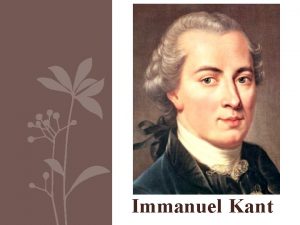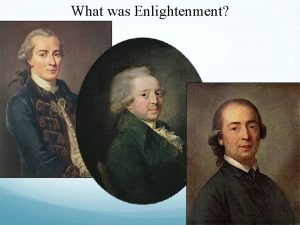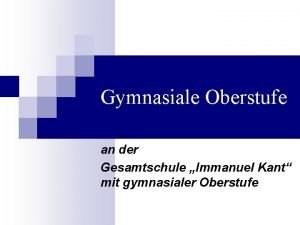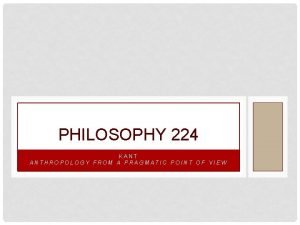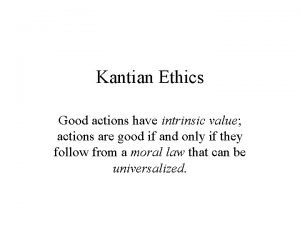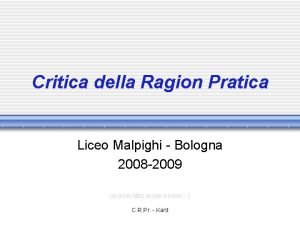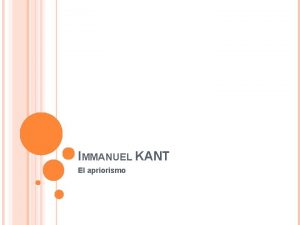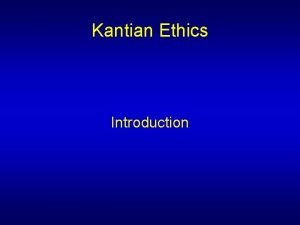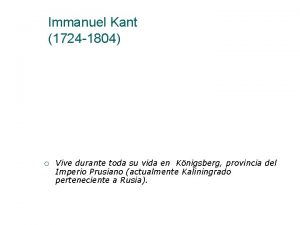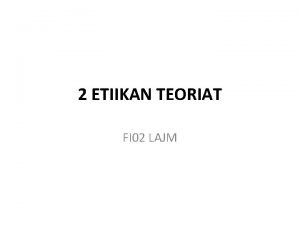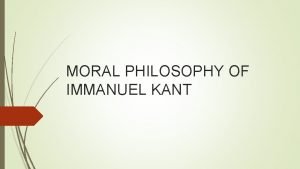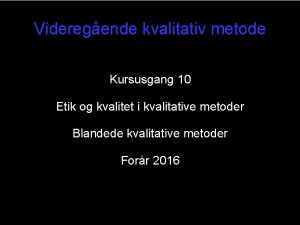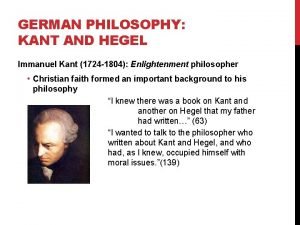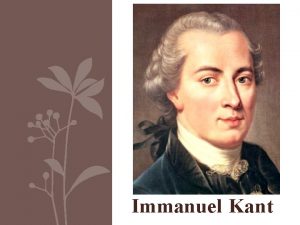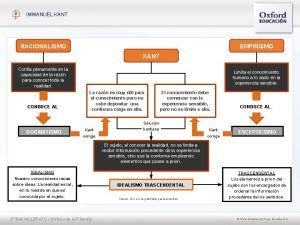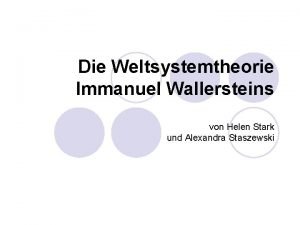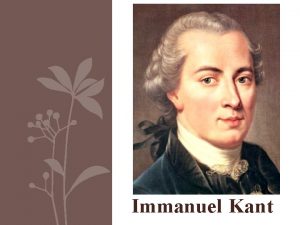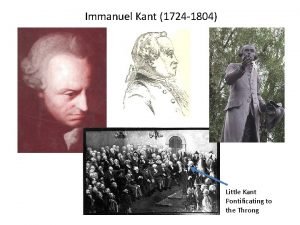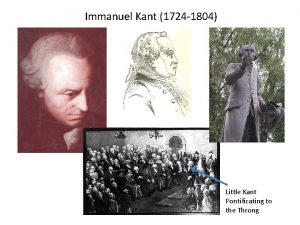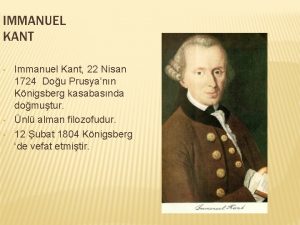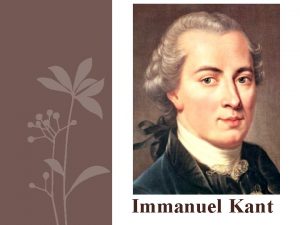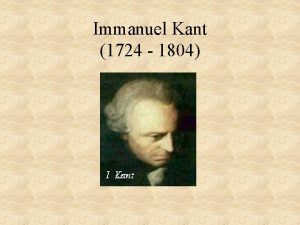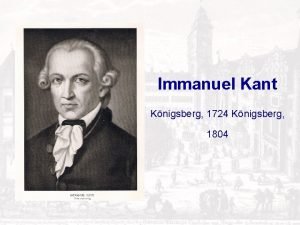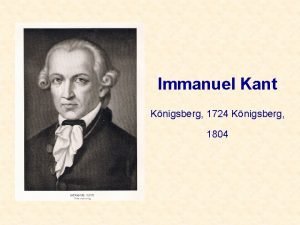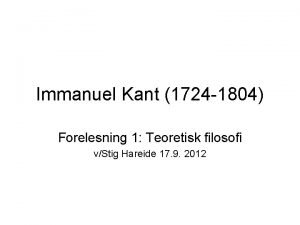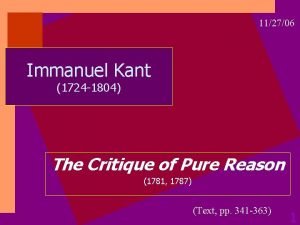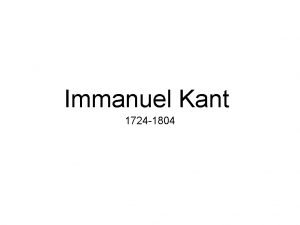4 2 Kant Immanuel Kant 1724 1804 is





































- Slides: 37

4. 2. Kant 康德

Ø Immanuel Kant (1724– 1804) is the central figure in modern philosophy. He synthesized early modern rationalism and empiricism, set the terms for much of nineteenth and twentieth century philosophy, and continues to exercise a significant influence today in metaphysics, epistemology, ethics, political philosophy, aesthetics, and other fields. Ø 康德是现代哲学的中心人物。他综合楼早期现代理 性主义和经验主义,为 19世纪和20世纪的大多数哲 学确定了术语,至今依然对形而上学、认识论、伦 理学、政治哲学、美学以及其他领域发挥着重要影响

批判哲学与三大批判 The fundamental idea of Kant's “critical philosophy” — especially in his three Critiques: the Critique of Pure Reason (1781, 1787), the Critique of Practical Reason (1788), and the Critique of the Power of Judgment (1790) — is human autonomy. Ø 康德“批判哲学”的基本观念——特别是其三大批判 的观念是人类自治。这三大批判是《纯粹理性批 判》(1781,1787),《实践理性批判》(1788 )与《判断力批判》(1790)。 Ø

4. 2. 1 康德美学的轮廓 Although we take its existence for granted now, Kant's third Critique could only have struck its original audience as a surprising and puzzling work. It was surprising, because neither the Critique of Pure Reason nor the Critique of Practical Reason had given any clue that another critique was to follow; Ø 尽管我们认为康德的第三批判的出现是顺理成章的, 但是,对于康德的最初读者而言,它既很令人惊奇, 又很令人迷惑。它之所以令人惊奇,是因为无论《纯 粹理性批判》还是《实践理性批判》都没有提供任何 线索,暗示前两个批判之后还有另外一个批判; Ø

and it was puzzling, because the book not only gives an extended treatment to one topic, namely aesthetic experience and judgment, which Kant had previously denied could be the subject of a science (Critique of Pure Reason, A 21/B 35 -6), but also links that topic with another, namely the teleological judgment of both organisms within nature and of nature as a whole, to which Kant had never before linked it. Ø 它之所以令人迷惑,是因为这本书不仅广泛地讨论 了一个论题,也就是审美体验和判断——康德以前 已经否定过它能够成为科学的对象(《纯粹理性批 判》 A 21/B 35 -6 );而且它还将那个论题与另外 一个论题,也就是对于自然中的有机体和自然整体 的目的论判断连在一起——康德此前从来没有连接 过它。 Ø

《判断力批判》美学部分的整体结构 Following the canonical model introduced into eighteenthcentury aesthetics by Burke and into Germany by Mendelssohn, Kant divides the first half of the Critique of the Power of Judgment, the “Critique of the Aesthetic Power of Judgment, ” into two main parts, the “Analytic of the Beautiful” and the “Analytic of the Sublime. ” Ø 康德追随 18世纪英国伯克与德国门德尔松所创立的正则 模型,将《判断力批判》的前半部“审美判断力批判”划 分为两个主要部分,一是“美的分析”,二是“崇高的分 析”。 Ø 说明:《判断力批判》的后半部是“目的论判断力批判” Ø

审美体验的三种形式 But Kant actually analyzes three main forms of aesthetic experience — the experience of beauty, paradigmatically natural beauty; the experience of the sublime, again paradigmatically of sublimity in nature; and the experience of fine art — and each of these forms of aesthetic experience ultimately reveals distinctive connections to morality. Ø 但是,康德实际上分析了审美体验的三种主要形式— —美的体验,以自然美为范式;崇高的体验,也是以 自然中的崇高为范式;美的艺术的体验。这三种审美 体验中的每一种,最终都显示了与道德的明确联系。 Ø


《判断力批判》及其四个译本 Immanuel Kant, Kritik der Urteilskraft, Kants gesammelte Schriften, Volume 5, Berlin: Walter de Gruyter, 1902–. Ø Immanuel Kant, Critique of Judgment, trans. Werner S. Pluhar (Indianapolis: Hackett Publishing, 1987. Ø Immanuel Kant, Critique of the Power of Judgment. edited by Paul Guyer; translated by Paul Guyer, Eric Matthews. Cambridge, UK; New York: Cambridge University Press, 2000, pp 89 -96. [德]康德:《判断力批判》,邓晓芒译,杨祖陶校,人民出 版社,2002年版,第 37 -45页。 Ø [德]康德:《判断力批判》(注释本),李秋零译注,中国 人民大学出版社,2011年版,第 33 -40页。 Ø

First Moment of the judgment of taste , concerning its quality. 鉴赏力的判断的第一契机,按照质来看 The definition of taste that is the basis here is that it is the faculty for the judging of the beautiful. But what is required for calling an object beautiful must be discovered by the analysis of judgments of taste. In seeking the moments to which this power of judgment attends in its reflection, I have been guided by the logical functions for judging (for a relation to the understanding is always contained even in the judgment of taste). I have considered the moment of quality first, since the aesthetic judgment on the beautiful takes notice of this first. Ø 这是康德为taste,也就是德语的Geschmacks所加的一 个注释,对于这个注释的准确把握,成为理解康德美 学的关键。我们逐句来分析。 Ø



判断一个对象是美的,需要什么呢? But what is required for calling an object beautiful must be discovered by the analysis of judgments of taste. In seeking the moments to which this power of judgment attends in its reflection, I have been guided by the logical functions for judging (for a relation to the understanding is always contained even in the judgment of taste). Ø 但是,称一个对象是美的所需要的东西,必须通 过分析鉴赏力的判断来发现。为了寻找这种判断 的能力参加其反思的契机,我一直遵循着判断的 逻辑功能(因为与知性的关系总是包含在鉴赏力 的判断中)。 Ø 邓、李都将“鉴赏力的判断”译为“鉴赏判断” Ø

对于美(者)的审美判断 ØI have considered the moment of quality first, since the aesthetic judgment on the beautiful takes notice of this first. Ø 我首先考察的契机是质,因为对于美(者) 的审美判断首先注意这一点。

First Moment of the judgment of taste, concerning its quality. 鉴赏力的判断的第一契机,按照质来看 Ø § 1. Ø The judgment of taste is aesthetic. Ø 鉴赏力的判断是审美的(感性的)

方式:判断某物是不是美的 In order to decide whether or not something is beautiful, we do not relate the representation by means of understanding to the object for cognition, but rather relate it by means of the imagination (perhaps combined with the understanding) to the subject and its feeling of pleasure or displeasure. Ø 为了断定某物是不是美的,我们不把通过知性所 获得的表象与认知的客体(对象)联系起来,而 是通过想像力(或许合并有知性)的方式,把它 与主体及其愉悦或不悦的感情联系起来。 Ø


Any relation of representations, however, even that of sensations, can be objective (in which case it signifies what is real in an empirical representation); but not the relation to the feeling of pleasure and displeasure, by means of which nothing at all in the object is designated, but in which the subject feels itself as it is affected by the representation. Ø 然而,各种表象之间的任何关系、甚至诸感觉的任 何关系,都可以是客体的(在这种情况下,它表示 经验表象中实在的东西);但是,这种关系并不是 与愉悦和不悦之间的关系——通过这种关系,客体 上的任何东西都没有被标明——而是在它里面,主 体就像受到这个表象的影响那样感觉自己。 Ø

Guyer的注释:p. 366. The argument that aesthetic judgments concern the relation of objects to the human subject rather than properties of the objects themselves, that feelings of pleasure and displeasure express this relation, and that aesthetic judgments therefore concern the pleasure or displeasure that the perception of objects produce in us is the chronological as well as logical starting point of Kant’s analysis of aesthetic judgments, and was present in his comments on aesthetics from the outset to the end. Ø 康德认为,审美判断关注各种客体与人类主体的关系,而不是诸 客体自身的种种属性;愉悦和不悦的感情表达了这种关系,因此, 审美判断关注对客体的知觉在我们身上所激发的愉悦或不悦。这 一论点始终贯穿在康德对于审美判断的分析中,并且是他的分析 的逻辑起点,而且,这一观点自始至终出现在他对于美学的评论 中。 Ø 对客体的知觉=表象 Ø

两种方式(能力) 面对同一个对象的两种反应 To grasp a regular, purposive structure with one’s faculty of cognition (whether the manner of representation be distinct or confused) is something entirely different from being conscious of this representation with the sensation of satisfaction. Ø 运用人的认知的能力去把握一座规则的、有目的 的建筑物(无论表象的方式是清晰还是混乱), 完全不同于凭借满足感去感知这个表象。 Ø 知新楼:做什么用的?很气派! Ø

Here the representation is related entirely to the subject, indeed to its feeling of life, under the name of the feeling of pleasure or displeasure, which grounds an entirely special faculty for discriminating and judging that contributes nothing to cognition but only holds the given representation in the subject up to the entire faculty of representation, of which the mind becomes conscious in the feeling of its state. Ø 在此,这个表象完全与主体相连,事实上与其生命 感情相连,可以称为愉悦感或不悦感——它基于一 种完全特殊的鉴别与判断的能力,它对于认知毫无 贡献,但它只把握主体中的特定表象,直到表象的 全部能力——对于这个表象,心灵在对其状态的感 受中变得清醒。 Ø

Given representations in a judgment can be empirical (hence aesthetic); however, the judgment that is made by means of them is logical if in the judgment they are related to the object. Conversely, however, even if the given representations were to be rational but related in a judgment solely to the subject (its feeling), then they are to that extent always aesthetic. Ø 判断中的那些特定表象可以是经验性的(因此是感 性的);然而,如果在判断中它们是与客体相连的 话,那么,凭借它们所做的判断则是逻辑的。相反, 即使这些特定的表象可以是合理的,但在判断中只 与主体(它的感情)相连,那么,它们就此而言总 是感性的(审美的)。 Ø 判断:客体-表象-主体 Ø

Ø § 2. Ø The satisfaction that determines the judgment of taste is without any interest. Ø 决定鉴赏力的判断的满足是没有任何利害 的


两个的问题:苹果好吃吗?苹果好看吗? But if the question is whether something is beautiful, one does not want to know whethere is anything that is or that could be at stake, for us or for someone else, in the existence of the thing, but rather how we judge it in mere contemplation (intuition or reflection). Ø 但是,如果问题是“某物是否是美的”,那么,人们 就不想知道,对于我们或对于其他人来说,是否 有任何东西要考虑,这个事物是否实际存在;而 是想知道,我们在纯粹的观赏(直觉或反思)中 如何判断它。 Ø

三个要点 Ø One only wants to know whether the mere representation of the object is accompanied with satisfaction in me, however indifferent I might be with regard to the existence of the object of this representation. Ø 人们只想知道,客体的单纯表象是否伴随 着我的满足,无论我对于这一表象的客体 的实存多么无所谓。



定义:愉悦或不悦的感情(Guyer, p. 366. ) Kant explained pleasure as the feeling that expresses a condition that promotes life and its activity, while the feeling of displeasure expresses a hindrance to life or a check to its activity; this conception is presupposed by Kant’s conception of the pleasure in the free play of the cognitive faculties, especially at § 9, 5: 219 below. Ø 康德的解释是:愉悦是表达促进生命及其活动的 状况的感情,而不悦的感情则是表达妨碍生命或 抑制其活动的感情。 Ø

纯粹的鉴赏力的判断 Everyone must admit that a judgment about beauty in which there is mixed the least interest is very partial and not a pure judgment of taste. One must not be in the least biased in favor of the existence of the thing, but must be entirely indifferent in this respect in order to play the judge in matters of taste. Ø 每个人都必须承认:关于美的判断只要混杂着一 点点利害,它就是很片面的,就不是纯粹的鉴赏 力的判断。对于事物的实际存在,人们必须一点 也不倾向去关注,而是必须完全漠视这个方面, 才能在鉴赏力的事务中充当评判员。 Ø

不可全解的难句 We can find no better way of elucidating this proposition, however, which is of the utmost importance, than by contrasting to the pure disinterested* satisfaction in the judgment of taste that which is combined with interest, especially if we can be certain that there are not more kinds of interest than those that are to be mentioned now. Ø 然而,对于这个极具重要性的主张,我们无法找到 更好的阐明方式了。有一种鉴赏力的判断混杂着利 害,它当中也有着纯粹的无利害的满足,特别是, 如果我们能够肯定,除了现在马上要列举的那几种 利害之外,再也没有更多的利害种类了。 Ø

Pluhar, p. 46. There is no better way to elucidate this proposition, which is of prime importance, than by contrasting the pure disinterested liking that occurs in a judgment of taste with a liking connected with interest, especially if we can also be certain that the kinds of interest I am about to mention are the only ones there are. Ø 这个主张最为重要,阐明它的最佳方式是比较如下 两类满足:在鉴赏力的判断中出现的纯粹无利害的 满足,与利害相连的满足。特别是,如果我们能够 肯定,我将讨论的利害只有下面将要论述的两种。 Ø


康德的注释 Ø A judgment on an object of satisfaction can be entirely disinterested yet still very interesting, i. e. , it is not grounded on any interest but it produces an interest; all pure moral judgments are like this. But the pure judgment of taste does not in itself even ground any interest. Only in society does it become interesting to have taste, the reason for which will be indicated in the sequel.

第 3、4节 Ø § 3. Ø The satisfaction in the agreeable is combined with interest. Ø 快适中的满足结合着利害 Ø § 4. Ø The satisfaction in the good is combined with interest. Ø 善中的满足结合着利害

第 5节 Ø § 5. Ø Comparison of the three specifically different kinds of satisfaction. Ø 比较三种特定不同的满足(愉悦)

一个对象什么情况下才能被称为是美的? Definition of the beautiful derived from the first moment. Ø 从第一契机所得到的美者的定义 Ø Taste is the faculty for judging an object or a kind of representation through a satisfaction or dissatisfaction without any interest. The object of such a satisfaction is called beautiful. Ø 鉴赏力是如下一种能力:通过没有任何利害的愉悦或 不悦,来判断一个对象或一种表象。这种愉悦的客体 被称为美的。 Ø the beautiful:准确的翻译应该是“美的对象”,李秋零 翻译为“美者”。 Ø the beautiful-beauty Ø
 Immanuel kant
Immanuel kant Knigsberg
Knigsberg Immanuel kant 1724 1804
Immanuel kant 1724 1804 Kant 1724 a 1804
Kant 1724 a 1804 Sistema solar conclusão
Sistema solar conclusão Gesamtschule immanuel kant
Gesamtschule immanuel kant Ideas of kant
Ideas of kant Kantinism
Kantinism Liceo immanuel kant
Liceo immanuel kant Kant giro copernicano
Kant giro copernicano Eticas formales
Eticas formales Critica trascendental
Critica trascendental Immanuel kant
Immanuel kant Example of kantianism
Example of kantianism The kantian triangle
The kantian triangle Teleological ethics example
Teleological ethics example Immanuel kant deontology
Immanuel kant deontology Sopimusetiikka
Sopimusetiikka Etica de kant
Etica de kant Kant sapere aude
Kant sapere aude Immanuel kant teori
Immanuel kant teori Idealismo kantiano
Idealismo kantiano Immanuel kant pligtetik
Immanuel kant pligtetik Imperativo categorico
Imperativo categorico Kant epistemology
Kant epistemology Immanuel kant human rights
Immanuel kant human rights Immanuel kant virgin
Immanuel kant virgin Immanuel kant's theory of categorical imperative
Immanuel kant's theory of categorical imperative Kantian ethics
Kantian ethics Hegel sunglasses
Hegel sunglasses Immanuel kant human rights
Immanuel kant human rights Empirismo immanuel kant
Empirismo immanuel kant Political risk examples
Political risk examples Mapa conceptual de la ley 1804 de 2016
Mapa conceptual de la ley 1804 de 2016 Da form 5811 r
Da form 5811 r Immanuel gawler
Immanuel gawler Kitab kolose
Kitab kolose Weltsystemtheorie
Weltsystemtheorie
